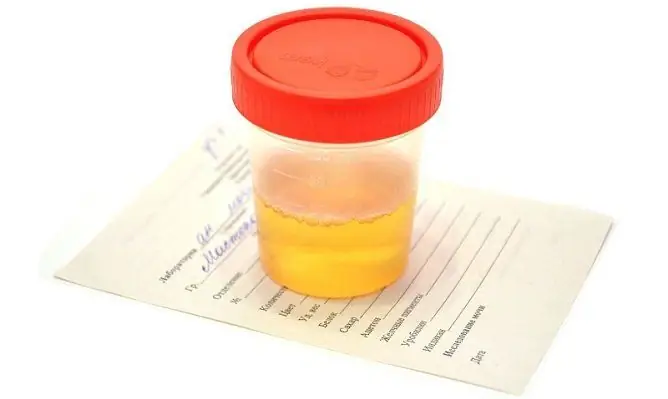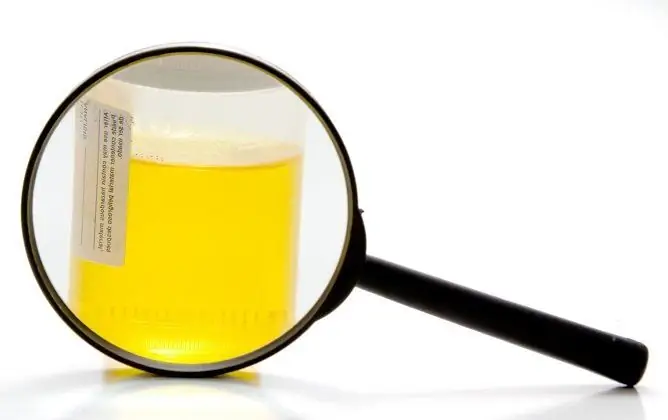- Author Rachel Wainwright [email protected].
- Public 2023-12-15 07:39.
- Last modified 2025-11-02 20:14.
Arfazetin
Arfazetin: instructions for use and reviews
- 1. Release form and composition
- 2. Pharmacological properties
- 3. Indications for use
- 4. Contraindications
- 5. Method of application and dosage
- 6. Side effects
- 7. Overdose
- 8. Special instructions
- 9. Application during pregnancy and lactation
- 10. In case of impaired renal function
- 11. Drug interactions
- 12. Analogs
- 13. Terms and conditions of storage
- 14. Terms of dispensing from pharmacies
- 15. Reviews
- 16. Price in pharmacies
Latin name: Arphasetin
ATX code: A10X
Active ingredient: St. John's wort herb (St. John's wort herb) + chamomile flowers (Chamomile flower) + common bean sash of fruit + field horsetail (Equisetum stem) + blueberry shoots (Blueberry shoot) + Dog rose fruit + Eleutherococcus rhizome and root
Producer: Ivan-Chai, CJSC (Russia), Viola Pharmaceutical Factory, CJSC (Ukraine)
Description and photo update: 2019-26-08

Arfazetin is a herbal medicine, the main action of which is aimed at lowering blood glucose, increasing tolerance to carbohydrates and enhancing the glycogen-forming function of the liver.
Release form and composition
Herbal collection is produced in the form of briquettes, powder and crushed raw materials.
The composition of Arfazetin includes the roots of Eleutherococcus, St. John's wort, chamomile flowers, common bean shells, field horsetail, blueberry shoots and rose hips.
Pharmacological properties
Pharmacodynamics
Arfazetine is one of the combined herbal preparations. The complex of biologically active substances that make up the drug has a hypoglycemic effect in type II diabetes. This allows in some cases to reduce the daily dose of oral antidiabetic drugs, to increase the carbohydrate tolerance. There is no noticeable hypoglycemic effect in type I diabetes mellitus.
The effect of the drug is due to the main biologically active substances contained in the collection components:
- St. John's wort (herb): anthracene derivatives (hypericin), flavonoids;
- common blueberries (shoots): flavonoids, anthocyanin glycoside myrtillin, etc.;
- rose hips (fruits): organic acids, vitamins C, P, carotenoids;
- common beans (fruit valves): triterpene glycosides, flavonoids (robinin, rutin);
- field horsetail (grass): flavonoids, saponins, silicic acid;
- chamomile (flowers): essential oil, flavonoids, mucus;
- eleutherococcus prickly (roots and rhizomes): pectin, glycosides, essential oil.
Indications for use
According to the instructions for use, Arfazetin is prescribed for diabetes mellitus of moderate and mild severity. It is possible both independent use of the drug and in combination with insulin preparations and sulfonylurea derivatives.
Contraindications
- arterial hypertension;
- decompensated diabetes mellitus;
- epilepsy;
- dyskinesia of the biliary tract;
- exacerbation of chronic pancreatitis or chronic enterocolitis;
- peptic ulcer;
- hyperthermic syndrome;
- nephrosis, nephritis, nephrosonephritis;
- increased irritability, insomnia;
- insufficiency of blood circulation;
- acute infectious diseases;
- myocardial infarction;
- arrhythmias;
- thrombophlebitis, as well as a tendency to develop it;
- cardiopsychoneurosis;
- endocarditis;
- cholelithiasis;
- severe kidney disease;
- pregnancy and lactation;
- hypersensitivity to any of the components in the collection.
Arfazetin, instructions for use: method and dosage
The drug in the amount of 1 sachet, 1 briquette or 1 tablespoon (10 g) of crushed raw materials should be placed in a pan, preferably enameled, pour 2 glasses (400 ml) of hot boiled water and hold for 15 minutes in a water bath. For at least 45 minutes, the broth should be infused at room temperature, then, having filtered and squeezed out the remaining raw materials, it is necessary to bring it to its original volume (2 cups), diluted with boiled water.
The cooked broth is taken half an hour before meals 2-3 times a day for 1 / 2-1 / 3 cup. The duration of treatment is usually 3-4 weeks, the recommended break between courses is 10-15 days. The greatest effectiveness of the drug is achieved when 3-4 courses are carried out during the year.
Side effects
- nervous system: decreased performance, anxiety, agitation, irritability, sleep disturbances;
- cardiovascular system: tachycardia, increased blood pressure;
- urinary system: irritation of kidney tissue (manifests itself as lower back pain and at the end of urination);
- allergic reactions: photosensitivity, hyperemia, rash, itching, skin edema.
Prolonged use of Arfazetin (longer than 2 months) can lead to the following adverse reactions: disorders of the gastrointestinal tract, muscle spasm.
Overdose
With an overdose of Arfazetin, an increase in the severity of side effects is possible.
special instructions
It is recommended to shake the infusion before use.
During the period of therapy, exposure to ultraviolet radiation should be avoided.
Influence on the ability to drive vehicles and complex mechanisms
During the use of the drug collection Arfazetin when driving vehicles and working with complex mechanisms, care should be taken (despite the lack of data confirming the effect of the drug on the reaction rate).
Application during pregnancy and lactation
Medicinal collection Arfazetin in diabetes mellitus during pregnancy / lactation is contraindicated.
With impaired renal function
In severe kidney disease, nephrosis, nephritis and nephrosonephritis, the drug is contraindicated.
Drug interactions
The combined use of Arfazetine in diabetes mellitus with anticoagulants, antibiotics, sulfonamides, contraceptives, antihypertensive (calcium channel blockers) and hypocholesterolemic (statins) drugs, female sex hormones, cardiac glycosides is not recommended.
When used as part of complex therapy, the agent can help to reduce the doses of oral antidiabetic drugs.
Other possible interactions of Arfazetine:
- enhancing the effect of analeptics, drugs that stimulate the central nervous system and drugs with hypoglycemic action;
- suppression of the action of hypnotics and sedatives.
Analogs
Arfazetin's analogs are Arfazetin-E, Arfazetin-EK.
Storage conditions and periods
Store at a temperature not exceeding 25 ° C.
The prepared infusion should be stored in the refrigerator for no more than 48 hours.
The collection period is 2 years.
Terms of dispensing from pharmacies
Available without a prescription.
Reviews about Arfazetin
Reviews of Arfazetin are mostly positive. It is noted that the drug does not cancel therapy with hypoglycemic agents, but is a supplement to it, along with the diet. They also indicate that in order to achieve a therapeutic effect, the drug should be taken as a course, especially in the initial stages of the disease. There are practically no reports of the development of adverse reactions.
The price of Arfazetin in pharmacies
The approximate price for Arfazetin (1 package of 50 g) is 77-85 rubles.

Maria Kulkes Medical journalist About the author
Education: First Moscow State Medical University named after I. M. Sechenov, specialty "General Medicine".
Information about the drug is generalized, provided for informational purposes only and does not replace the official instructions. Self-medication is hazardous to health!






